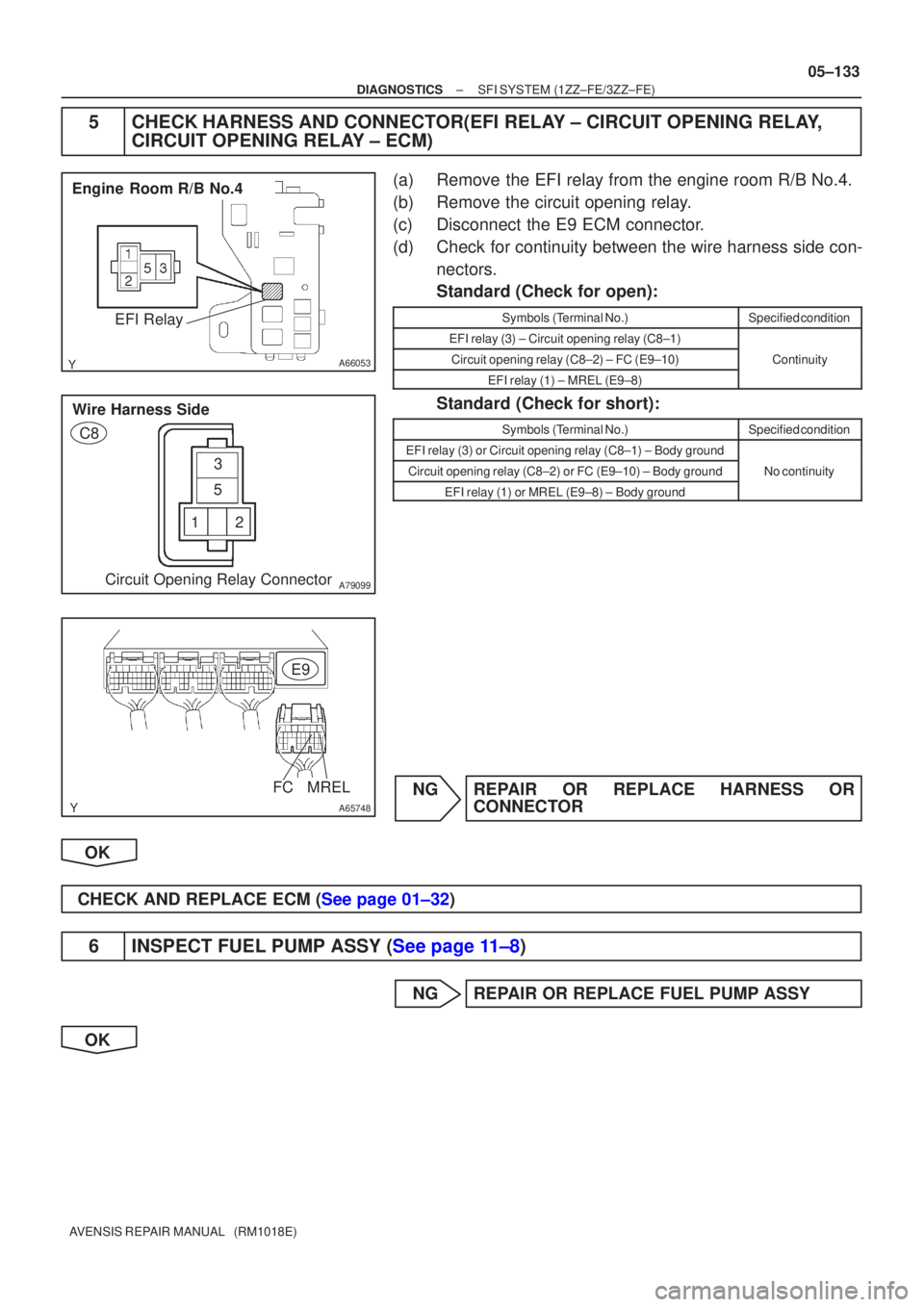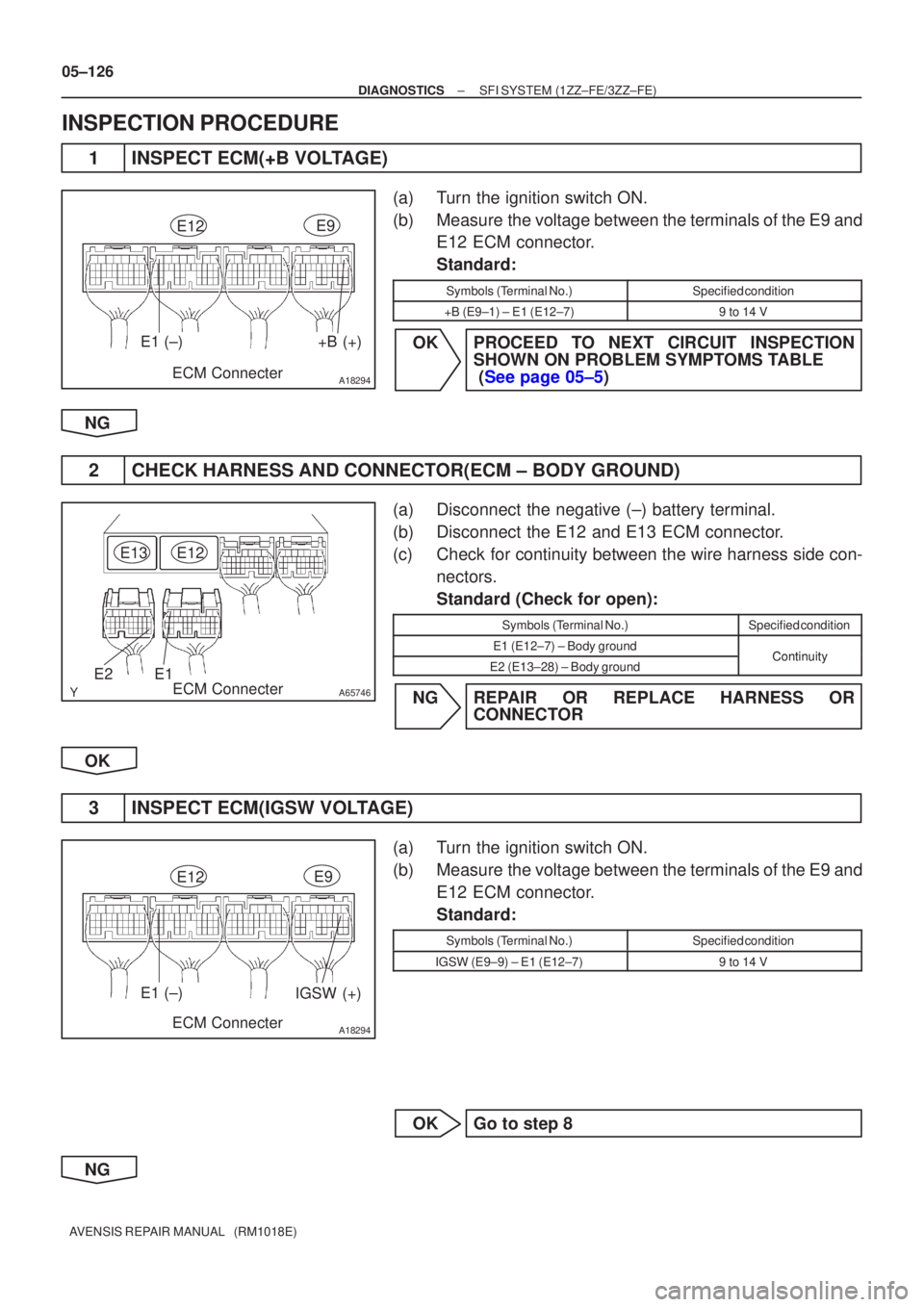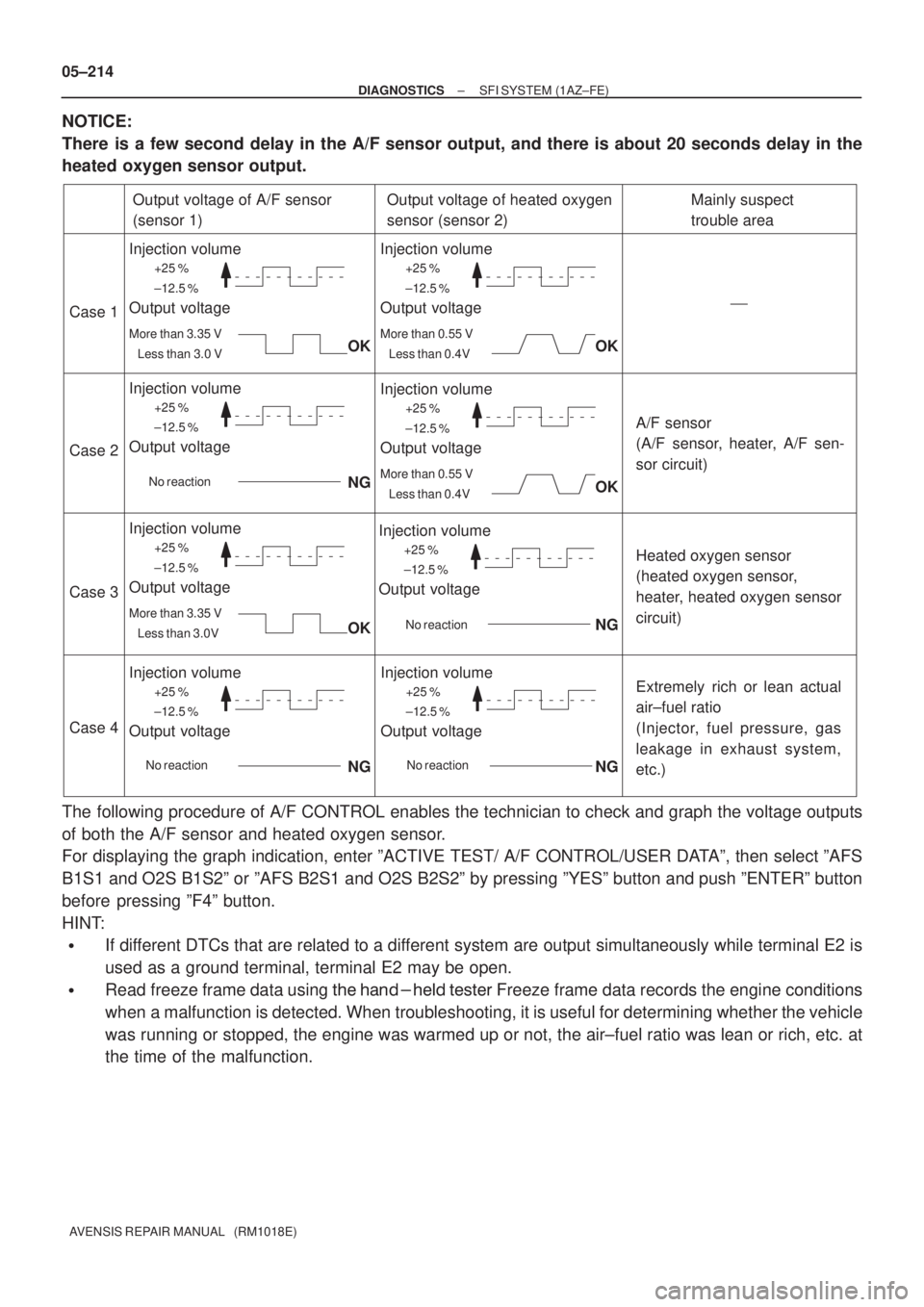Page 314 of 5135
B16200
C8
A18294
FC (+)E1 (±)
ECM Connector
E12E9
05±132
± DIAGNOSTICSSFI SYSTEM (1ZZ±FE/3ZZ±FE)
AVENSIS REPAIR MANUAL (RM1018E)
3 INSPECT CIRCUIT OPENING RELAY
(a) Remove the circuit opening relay.
(b) Inspect the circuit opening relay.
Standard:
Terminal No.Specified condition
1 ± 2Continuity
No Continuity
3 ± 5Continuity
(Apply battery voltage Terminals 1 and 2)
NG REPLACE CIRCUIT OPENING RELAY
OK
4 INSPECT ECM
(a) Turn the ignition switch ON.
(b) Measure the voltage between the terminals of the E9 and
E12 ECM connector.
Standard:
Symbols (Terminal No.)Specified condition
FC (E9±10) ± E1 (E12±7)8 to 14 V
OK Go to step 6
NG
Page 315 of 5135

A66053
Engine Room R/B No.4EFI Relay
123
5
A79099
Wire Harness Side
C8
Circuit Opening Relay Connector
A65748
E9
MRELFC
±
DIAGNOSTICS SFI SYSTEM(1ZZ±FE/3ZZ±FE)
05±133
AVENSIS REPAIR MANUAL (RM1018E)
5CHECK HARNESS AND CONNECTOR(EFI RELAY ± CIRCUIT OPENING RELAY,
CIRCUIT OPENING RELAY ± ECM)
(a)Remove the EFI relay from the engine room R/B No.4.
(b)Remove the circuit opening relay.
(c)Disconnect the E9 ECM connector.
(d)Check for continuity between the wire harness side con-
nectors.
Standard (Check for open):
Symbols (Terminal No.)Specified condition
EFI relay (3) ± Circuit opening relay (C8±1)
Circuit opening relay (C8±2) ± FC (E9±10)Continuity
EFI relay (1) ± MREL (E9±8)
y
Standard (Check for short):
Symbols (Terminal No.)Specified condition
EFI relay (3) or Circuit opening relay (C8±1) ± Body ground
Circuit opening relay (C8±2) or FC (E9±10) ± Body groundNo continuity
EFI relay (1) or MREL (E9±8) ± Body ground
y
NGREPAIR OR REPLACE HARNESS OR CONNECTOR
OK
CHECK AND REPLACE ECM (See page 01±32)
6INSPECT FUEL PUMP ASSY (See page 11±8)
NG REPAIR OR REPLACE FUEL PUMP ASSY
OK
Page 316 of 5135
123
5
A79099
Wire Harness Side
C8
Circuit Opening Relay Connector
A66276
Fuel Pump Connector
Wire Harness Side
F25
05±134
±
DIAGNOSTICS SFI SYSTEM(1ZZ±FE/3ZZ±FE)
AVENSIS REPAIR MANUAL (RM1018E)
7CHECK HARNESS AND CONNECTOR(CIRCUIT OPENING RELAY ± FUEL PUMP, FUEL PUMP ± BODY GROUND)
(a)Remove the circuit opening relay.
(b)Disconnect the fuel pump connector.
(c)Check for continuity between the wire harness side con-
nectors.
Standard (Check for open):
Symbols (Terminal No.)Specified condition
Circuit opening relay (C8±3) ± Fuel pump (F24±4)ContinuityFuel pump (F25±5) ± Body groundContinuity
Standard (Check for short):
Symbols (Terminal No.)Specified condition
Circuit opening relay (C8±3) or Fuel pump (F24±4) ±
Body groundNo continuity
NGREPAIR OR REPLACE HARNESS ORCONNECTOR
OK
CHECK AND REPLACE ECM (See page 01±32)
Page 317 of 5135
05±124
± DIAGNOSTICSSFI SYSTEM (1ZZ±FE/3ZZ±FE)
AVENSIS REPAIR MANUAL (RM1018E)
ECM POWER SOURCE CIRCUIT
CIRCUIT DESCRIPTION
When the ignition switch is turned ON, battery positive voltage is applied to terminal IGSW of the ECM and
the EFI relay (Marking: EFI) control circuit in the ECM sends a signal to terminal MREL of the ECM switching
on the EFI relay.
This signal causes current to flow to the coil, closing the contacts of the EFI relay and supplying power to
terminal +B of the ECM.
If the ignition switch is turned off, the ECM continues to switch on the EFI relay for a maximum of 2 seconds
for the initial setting of the throttle valve.
05C6G±01
Page 319 of 5135

A18294
E1 (±)+B (+)
ECM Connecter
E12E9
A65746
E1
E2
E13E12
ECM Connecter
A18294ECM Connecter
E12E9
E1 (±)IGSW (+)
05±126
±
DIAGNOSTICS SFI SYSTEM(1ZZ±FE/3ZZ±FE)
AVENSIS REPAIR MANUAL (RM1018E)
INSPECTION PROCEDURE
1INSPECT ECM(+B VOLTAGE)
(a)Turn the ignition switch ON.
(b)Measure the voltage between the terminals of the E9 and E12 ECM connector.
Standard:
Symbols (Terminal No.)Specified condition
+B (E9±1) ± E1 (E12±7)9 to 14 V
OKPROCEED TO NEXT CIRCUIT INSPECTION SHOWN ON PROBLEM SYMPTOMS TABLE
(See page 05±5)
NG
2 CHECK HARNESS AND CONNECTOR(ECM ± BODY GROUND)
(a) Disconnect the negative (±) battery terminal.
(b) Disconnect the E12 and E13 ECM connector.
(c) Check for continuity between the wire harness side con- nectors.
Standard (Check for open):
Symbols (Terminal No.)Specified condition
E1 (E12±7) ± Body groundContinuityE2 (E13±28) ± Body groundContinuity
NG REPAIR OR REPLACE HARNESS OR CONNECTOR
OK
3 INSPECT ECM(IGSW VOLTAGE)
(a) Turn the ignition switch ON.
(b) Measure the voltage between the terminals of the E9 and E12 ECM connector.
Standard:
Symbols (Terminal No.)Specified condition
IGSW (E9±9) ± E1 (E12±7)9 to 14 V
OK Go to step 8
NG
Page 324 of 5135

���\b�A79115
Reference (Bank 1 Sensor 2 System Drawing)Heated Oxygen Sensor
EFI Relay
Heater
SensorOX1B HT1BECM
From
Battery EFI Fuse
O1B±
MREL
EFI No.2 Fuse
05±218
±
DIAGNOSTICS SFI SYSTEM(1AZ±FE)
AVENSIS REPAIR MANUAL (RM1018E)
DTCP0141/27OXYGEN SENSOR HEATER CIRCUIT MALFUNCTION (BANK 1 SENSOR 2)
DTCP0161/29OXYGEN SENSOR HEATER CIRCUIT (BANK 2 SENSOR 2)
CIRCUIT DESCRIPTION
Refer to DTC P0136/27 on page 05±211.
HINT:
The ECM provides a pulse width modulated control circuit to adjust current \
through the heater. The heated
oxygen sensor heater circuit uses a relay on the B+ side of the circuit.
DTC No.DTC Detection ConditionTrouble Area
P0141/27
Heated current is 0.2 A or less when heater operates
(1 trip detection logic)�Open or short in heater circuit of heated oxygen sensor
� Heated oxygen sensor heater
P0141/27
P0161/29When heater operates, heated current exceeds 2 A
(1 trip detection logic)
yg
�EFI relay
� ECM
HINT:
�Bank 1 refers to the bank that includes cylinder No.1.
�Bank 2 refers to the bank that does not include cylinder No.1.
�Sensor 1 refers to the sensor closest to the engine assembly.
�Sensor 2 refers to the sensor farthest away from the engine assembly.
WIRING DIAGRAM
Refer to DTC P0136/27 on page 05±211.
INSPECTION PROCEDURE
HINT:
�If different DTCs that are related to a different system are output simultaneously while terminal E2 is
used as a ground terminal, terminal E2 may be open.
�Read freeze frame data using �
\f
���
\f�� �\f��\f�� Freeze frame data records the engine conditions
when a malfunction is detected. When troubleshooting, it is useful for d\
etermining whether the vehicle
was running or stopped, the engine was warmed up or not, the air±fuel ra\
tio was lean or rich, etc. at
the time of the malfunction.
05C6Y±01
Page 328 of 5135

A66651A±A SectionAir Solid Electrolyte
(Zirconia Element)
Platinum ElectrodeHeater
Exhaust Gas
CoverIdeal Air±Fuel Mixture
Output Voltage
Richer ± Air Fuel Ratio ± Leaner Element
AA
± DIAGNOSTICSSFI SYSTEM (1AZ±FE)
05±211
AVENSIS REPAIR MANUAL (RM1018E)
DTC P0136/27 OXYGEN SENSOR CIRCUIT MALFUNCTION
(BANK 1 SENSOR 2)
DTC P0156/29 OXYGEN SENSOR CIRCUIT MALFUNCTION
(BANK 2 SENSOR 2)
CIRCUIT DESCRIPTION
The heated oxygen sensor is the lamination type. Compared to the conventional type, the sensor and heater
portions of the lamination type are narrower overall. Because the heat of the heater acts directly on the alumi-
na and zirconia (of the sensor portion) it accelerates the activation of the sensor.
To obtain a high purification rate for the CO, HC and NOx components of the exhaust gas, a three±way cata-
lytic converter is used. But for the most efficient use of the three±way catalytic converter, the air±fuel ratio
must be precisely controlled so that it is always close to the stoichiometric air±fuel ratio.
The heated oxygen sensor has the characteristic whereby its output voltage changes suddenly in the vicinity
of the stoichiometric air±fuel ratio. This is used to detect the oxygen concentration in the exhaust gas and
provide the ECM with feedback control the air±fuel ratio.
When the air±fuel ratio becomes LEAN, the oxygen concentration in the exhaust gas increases. And the
heated oxygen sensor informs the ECM of the LEAN condition (low voltage, i.e. less than 0.45 V).
When the air±fuel ratio is RICHER than the stoichiometric air±fuel ratio, the oxygen concentration in the ex-
haust gas is reduced. And the heated oxygen sensor informs the ECM of the RICH condition (high voltage,
i.e. more than 0.45 V). The ECM judges by the voltage output from the heated oxygen sensor whether the
air±fuel ratio is RICH or LEAN and controls the injection time accordingly. However, if the malfunction of the
heated oxygen sensor causes an output of abnormal voltage, the ECM becomes unable to perform accurate
air±fuel ratio control.
The heated oxygen sensors include a heater which heats the zirconia element. The heater is controlled by
the ECM. When the intake air volume is low (the temperature of the exhaust gas is low), current flows to the
heater in order to heat the sensor for the accurate oxygen concentration detection.
DTC NoDTC Detection ConditionTrouble Area
The following condition continues for 480 sec. or more:�Open or short in heated oxygen sensor (bank 1, 2 sensor 2)
circuitP0136/27
P0156/29
g
�During driving with the engine warmed up, voltage output of
the heated oxygen sensor remains at 0.45 V or more, or 0.60circuit
�Heated oxygen sensor (bank 1, 2 sensor 2)
Heated o gen sensor heater (bank 1 2 sensor 2)P0156/29the heated oxygen sensor remains at 0.45 V or more, or 0.60
V or less.�Heated oxygen sensor heater (bank 1, 2 sensor 2)
�EFI relay
05C6X±01
Page 331 of 5135

+25 %
±12.5 %
More than 3.35 V
Less than 3.0 V
Case 1
Case 2
Case 3
Case 4
Output voltage of A/F sensor
(sensor 1)
Injection volume
Output voltage
Output voltage of heated oxygen
sensor (sensor 2)Mainly suspect
trouble area
OK
+25 %
±12.5 %
More than 3.35 V
Less than 3.0V
Injection volume
Output voltage
+25 %
±12.5 %
More than 0.55 V
Less than 0.4V
Injection volume
Output voltage
A/F sensor
(A/F sensor, heater, A/F sen-
sor circuit)
+25 %
±12.5 %
More than 0.55 V
Less than 0.4V
Injection volume
Output voltage
+25 %
±12.5 %
Injection volume
Output voltage
NG
+25 %
±12.5 %
Injection volume
Output voltage
NG
+25 %
±12.5 %
Injection volume
Output voltage
NG
+25 %
±12.5 %
Injection volume
Output voltage
NGExtremely rich or lean actual
air±fuel ratio
(Injector, fuel pressure, gas
leakage in exhaust system,
etc.) OK
OK
OK
No reaction
No reaction
No reaction No reaction
�
Heated oxygen sensor
(heated oxygen sensor,
heater, heated oxygen sensor
circuit) 05±214
± DIAGNOSTICSSFI SYSTEM (1AZ±FE)
AVENSIS REPAIR MANUAL (RM1018E)
NOTICE:
There is a few second delay in the A/F sensor output, and there is about 20 seconds delay in the
heated oxygen sensor output.
The following procedure of A/F CONTROL enables the technician to check and graph the voltage outputs
of both the A/F sensor and heated oxygen sensor.
For displaying the graph indication, enter ºACTIVE TEST/ A/F CONTROL/USER DATAº, then select ºAFS
B1S1 and O2S B1S2º or ºAFS B2S1 and O2S B2S2º by pressing ºYESº button and push ºENTERº button
before pressing ºF4º button.
HINT:
�If different DTCs that are related to a different system are output simultaneously while terminal E2 is
used as a ground terminal, terminal E2 may be open.
�Read freeze frame data using ��� ��������� ��
�� Freeze frame data records the engine conditions
when a malfunction is detected. When troubleshooting, it is useful for determining whether the vehicle
was running or stopped, the engine was warmed up or not, the air±fuel ratio was lean or rich, etc. at
the time of the malfunction.